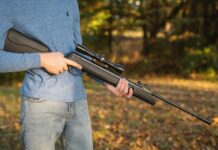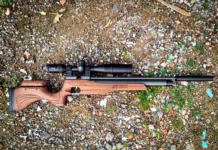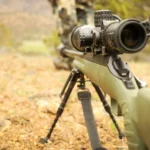It seems, for the commercial pistol market, the future is in your holster.
The last half-decade has seen a veritable onslaught of options from every major manufacturer we can think of — from the first-generation of true pocket pistols, focused on “shrink it down and smooth it out,” to the current iteration of modular, high-capacity models with shorter sights and longer grips that are too big for your pocket but too small for your duty belt.
But there’s one pistol platform that never really fit in with the slick carry gun crowd — the 19/2011 genre of pistols. It’s not that these guns are strangers to the concealed carry role. In fact, Rock Island Arsenal devised the “General Officer’s Model Pistol” in the early 1970s.
This was a junior-sized variant of the 1911A1 with a 4.25-inch barrel, similar in form factor to the Colt Commander. Shortly after this, Detonics released their 3.5-inch Combat Master. In the mid-1980s, Colt followed suit with the Officer’s ACP, sharing that 3.5-inch barrel length.
Unfortunately, the Officer’s ACP quickly gained a reputation for being very snappy and not very reliable. Compared to modern striker-fired pistols, the 19/2011’s action is a little more complex, and cramming all those parts into such a restricted living space tends to create issues.
Since then, a number of companies have released 3.5- and even 3-inch 19/2011-style pistols in both single- and double-stack configurations. As a whole, they’ve seen mixed results over the years, but conventional wisdom has held that, once you shrink the 19/2011 operating system below 4 inches, performance takes a nose-dive.
Enter the new Staccato CS. Staccato has spent the last several years laboring to make the double-stack 2011 — once solely considered to be a rich man’s gamer gun — both ruggedized and accessible to the masses.
The team at Staccato tells us that their pistols are now approved for duty use by more than 700 law enforcement agencies across the country, no small feat considering that the first-generation Staccato P launch was covered in these pages less than five years ago. Since then, they’ve brought an entire line of 2011s to market for duty, carry, and competition use.

The most diminutive of those was the single-stack Staccato C, with a 3.9-inch barrel, which was released in tandem with the C2, a double-stack model of the same length that could accept the entire range of full-size 2011 magazines from abbreviated 16-rounders all the way up to 26-round “happy sticks.” Certainly short enough for a carry holster, both the C and C2 still nicked the edge of that unspoken 4-inch minimum length for reliability and smooth operation.
The Staccato C was discontinued from production in late 2022. We heard rumors of this in advance, with whispers that its replacement would be a new, even-shorter double-stack model. Admittedly, we were wary of the swap. We really enjoyed the slimmer, single-stack profile of the C, finding that the “Officer Double Stack” grip on the C2 was a little too wide for us to carry without a sport coat or sweatshirt to cover it up.

We were also keenly aware of the functional issues that could arise from shrinking a 2011 to the forbidden length. The bottom line is that we expected a sawed-off C2 and were skeptical of that concept’s merit. Then, we got our hands on the CS. It was explained to us at unveiling time that the CS includes several proprietary internal and external design changes.
After getting up-close and personal with it, the Staccato CS has not only transcended our previously held notions about 3.5-inch 19/2011 pistols, but recaptured our interest in the evolution of the 2011 as a platform.
Table of Contents
SKIN DEEP
For the uninitiated, 2011s consist of three main parts: the polymer grip module, the metal frame (dust cover, rails, skeleton for the grip, and some other parts), and the upper half — the slide and everything inside it. These pieces aren’t plug-and-play across sizes and models, though gunsmiths and enthusiastic tinkerers have managed to find some combinations that work between existing Staccato variants.
Both the grip module and frame on the CS are completely different from any existing Staccato. We’ll talk more about the frame shortly, but the grip circumference is significantly reduced compared to previous models.

They also toned down the texture a little. If you’re familiar with the wraparound “star stamp” texture on larger Staccatos, you’ll know it’s a good aggressive treatment for hard shooting, but less optimal for against-the-body carry. By contrast, the CS grip sports a fine-grit sandy texture with more refined contours.
That grip is designed around a new magazine. There’s good news and bad news here. The bad news is, if you already have one or more full-size 2011s, those magazines won’t be cross compatible with the Staccato CS. With 2011 mag prices reaching well-north of $50 each, we understand if the idea of having to start a second mag collection to feed the CS might be disconcerting.
But these 16-round sticks are leaner, with an improved follower design to optimize feeding at the steeper angle required in short guns, and every CS pistol will ship with three of them in the case. Not only is this a general value-add, it’s also the typical number of mags required for a two- or three-day pistol class. In our mind, this is Staccato’s attempt to send potential buyers a message — the CS is a carry gun that’s meant to be shot as much as it’s carried.

To the same end, the CS also comes optics-ready, with a section of Picatinny rail on the dust cover for a carry light. In our testing, only two lights would fit properly on the Staccato CS light rail: SureFire’s XSC and Streamlight’s TLR-7 Sub. Since both lights are handgun-specific, make sure you pick up the 1913 rail version. None of the larger weapon lights we tried would fit.
BEAUTY ON THE INSIDE
While we appreciate the aesthetic and ergonomic updates, where the CS really makes its money is under the hood. Staccato has made some meaningful changes to the internal design, with the aim of amplifying all of the existing advantages of the 2011.
One of the most noticeable design changes is that the CS is Staccato’s first model to feature an external extractor. To 19/2011 purists, this may appear at first as a step backwards. Especially in the 1911 world, external extractors are sometimes considered a warning sign of mass-produced pistols that have not felt the gentle touch of gunsmith that all 1911s inherently require.
Sometimes they’re seen as a sign of laziness or lack of knowledge on how to properly tune a traditional extractor.

We think it’s safe to say that Staccato pistols aren’t built lazily or without knowledge of the platform. When talking with the Staccato team, they said the switch to external extractors was made for a couple of reasons. One was ease-of-maintenance for the armorers at those 700-plus professional agencies that authorize or issue Staccatos on a widespread basis, since the spring or even the entire extractor can be replaced without having to detail strip the slide.
The other is consistency. They can drop the same extractor, with the same matching spring, into each and every CS, as opposed to having to hand tune a traditional extractor, which introduces some element of human variance between pistols. They also tell us that even with zero tension (a round manually hung on the hook falls off), their external extractors pulled spent brass effectively and repeatedly during normal firing.
With Staccato’s hard focus on the LE duty market, refining their design to run under the worst possible conditions is an ever-present goal.

Once you get the slide off the gun, you’ll notice the CS also has continuous, full-length frame rails. Larger model Staccatos have interrupted frame rails, a requirement to accommodate their full-size double-stack magazines.
But with the narrower profile of the new CS magazines, full-length frame rails become possible again — a boon to slide/frame fit and accuracy. Staccato designers went one step further by cutting thin grooves on the inside of the rails to hold lubricant on the rails longer.
It was previously held wisdom that thinner lubricant was generally preferred by Staccato pistols, to permeate the tight slide/frame fit. The side effect of this tight fit is that lubricant can be pushed or worn off the rails more quickly and that built-up carbon doesn’t have anywhere else to go.
The new frame rails, in addition to lubricating grooves, also have small half-moon cuts on either end so that grit and debris can be pushed out of the rail grooves as the slide reciprocates.

How well does all this stuff work? Staccato tells us that all of their previous testing has yielded a rough bracket of 1,000 to 2,000 rounds before the slide loses lubrication and starts dragging on the frame rails from carbon buildup. With the new rails on the CS, pre-production test samples were able to run 3,000 to 4,000 rounds before those effects set in, since lubricant can remain on the rails longer and build-up can be “scrubbed out” more easily during the firing cycle.
While the CS’s short barrel is fluted, they’re applied sparingly and specifically. There are two longitudinal flutes applied at the 4- and 8-o’clock positions on the barrel. While they might not do much to reduce weight, their purpose is to act as a heat-release feature.
The shorter CS action, combined with increased amount of metal-to-metal contact between the barrel, slide, and frame, opens the door for rapid heating of the pistol during high volume shooting.
Much like the inclusion of three magazines, the design logic of including a couple barrel flutes points squarely to the notion of training with your carry pistol consistently and aggressively.
Finally, there were some changes made to the recoil system to optimize it for reliability in the shorter workspace of the CS frame. We do know it’s a toolless, multi-stage system with some similarity to previous designs, but Staccato was pretty tight-lipped on the specific changes made here. Regardless, we found the system to work consistently and effectively for managing recoil, even during sustained rapid-fire testing.
ROUNDS DOWNRANGE
Our very first rounds downrange on the CS were shot at Staccato’s live launch event, where they had several different courses of fire set up to highlight various aspects of the CS’s performance capability. We started on the long-range challenge, which had C-zone steel arrayed from 50 to 200 yards. In our first six shots fired through the CS, we scored hits on 50-, 75- and 100-yard steel. That set the tone for the remainder of our range testing.
Over the course of the following 500 to 700 rounds, we put the CS into as many hands as we could, including the range staff at our receiving FFL, several student athletes from the Wildgats Scholastic Shooting team at University of Arizona, and most of the RECOIL editorial team.

This subcompact powerhouse received universal high remarks and only suffered one stoppage — the result of a squib load while shooting some 147-grain subsonic rounds. Once we tapped the slug out of the chamber and reassembled the gun, it continued to run like a Swiss watch for the duration of our testing.
LOOSE BRASS
Staccato announced that the first CS pistols should be shipping to dealers by the end of 2022, so as you read this, you should be free to go pick one up, if the $2,499 MSRP doesn’t stop you from leaping off the couch.
The price of admission has never been low for 2011s. But it’s worth noting that a highly accurate, highly reliable Staccato costs about half of what it would have taken to get the same level of performance from a 2011 a few years ago. They also don’t require aftermarket assistance to live up to their potential.
SPECS:
Staccato CS
- Caliber: 9x19mm
- Capacity: 16+1
- Barrel Length: 3.5 inches
- Overall Length: 7.1 inches
- Weight: 22.7 ounces
- MSRP: $2,499
ACCESSORIES
- Optic: Holosun 507C $309
- Light: SureFire XSC $359
- Price as shown: $3,167










































